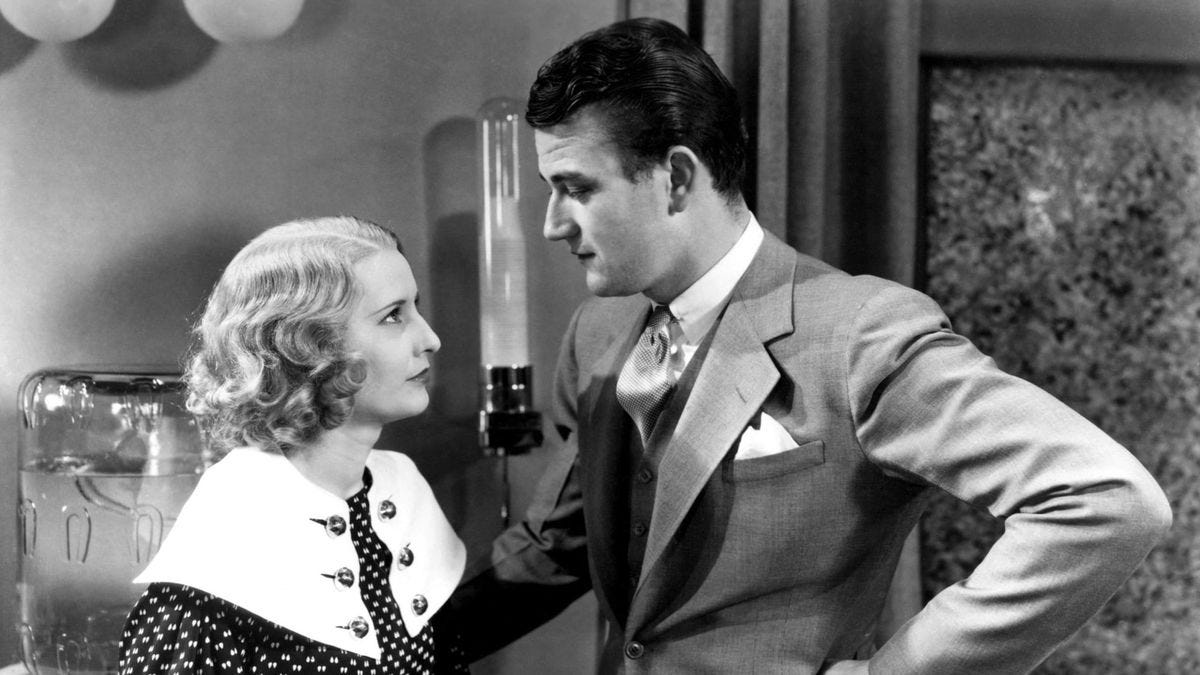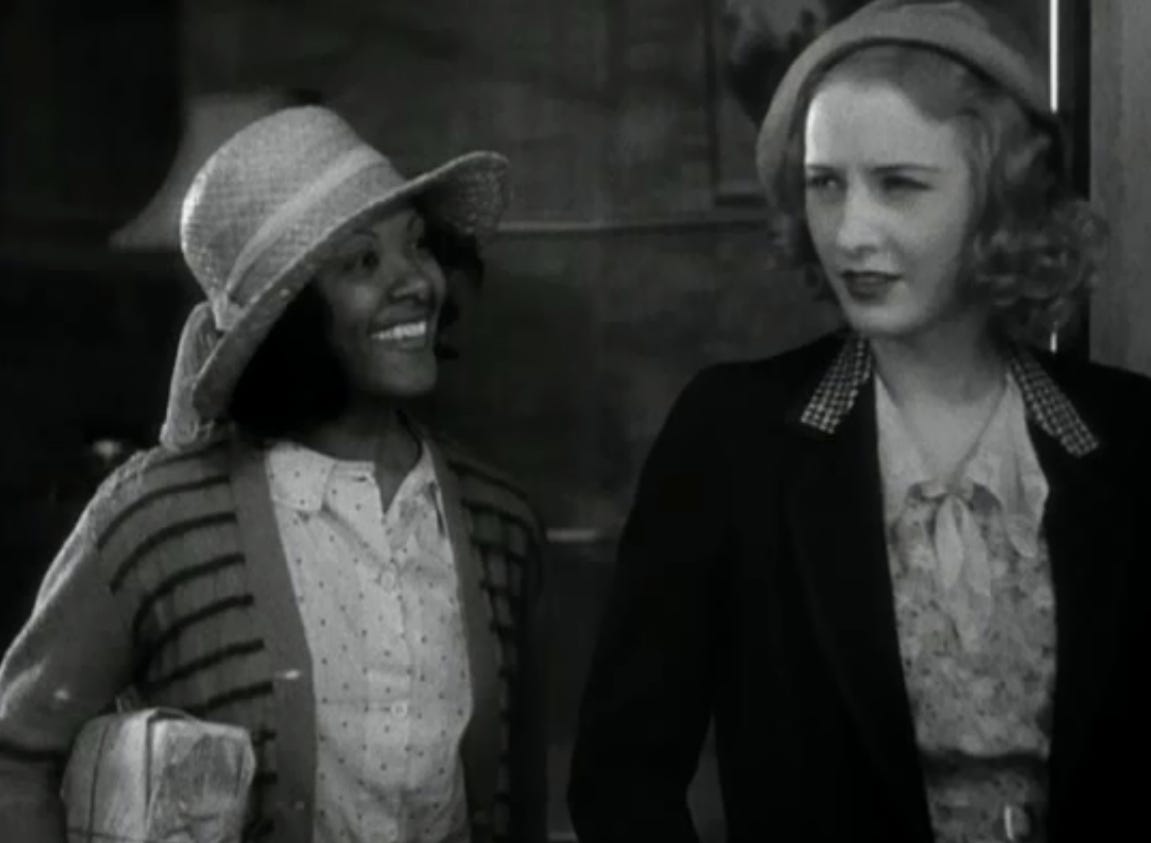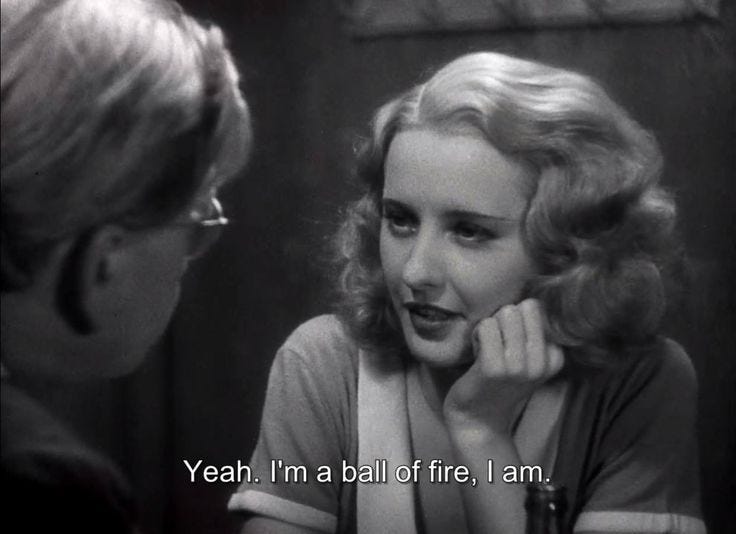Baby Face (1933) Review
The film that made Barbara Stanwyck a star, and almost made Joseph Breen’s head explode
Dear Readers,
This week, I decided to finally check out another film in Barbara Stanwyck’s filmography by watching 1933’s Baby Face. Known as one of the most notorious films of the Pre-Code Hollywood era and as one of the films that helped bring the era to a close when the enforcement of the code became stricter in 1934, Baby Face is a sexually-charged “fallen woman” film based on a story written by Daryl F. Zanuck.
Barbara Stanwyck stars as Lily Powers, a young, beautiful, embittered woman who works for her sleazebag father (Robert Barrat) in a speakeasy. She trusts no one other than a cobbler, who is an admirer of Friedrich Nietzsche and is upset with her lack of ambition. After her father passes in a still explosion, the cobbler motivates Lily with Nietzsche’s philosophy to use her power over men to get what’s hers.
She eventually leaves town, with her African American friend & co-worker Chico (Theresa Harris) to New York City. Upon arriving, she becomes determined to use her body and sexuality to help her climb the social ladder of the Gotham Trust Building. We then follow Lily as she seduces man after man and blazes a path from the filing department to the top floor that leads those in her way in financial ruin or dead.

For this first viewing, I watched the prerelease version. This version of the film was previously lost, until 2004 when a film vault worker at the Library of Congress happened to stumble upon it in the collection. Upon comparing the prerelease version to the version that had been in existence all these years before then (now known as the theatrical version), it was noted that there were about five minutes of additional footage, including a brand-new ending that was not in the theatrical version.
In the theatrical version, the ending is a redemption for our heroine. However, in this prerelease version, there is no redemption for her, no remorse for her actions, and no resolution as the heroine remains just as determined and callous as she was in the beginning of the film. There were also a few different shots and a rewriting of the speech given by the cobbler to Powers before she leaves for the big city that greatly changes the moral philosophy of the film. In this prerelease version, it’s clear as daylight that her success is directly correlated with her sleeping with each one of these men as she climbs up the social ladder.
These rewrites and cuts were largely due to the prerelease version being rejected by the New York State Censorship Board in April of 1933. Even though the Hays code hadn’t fully gotten its teeth yet, the film was so suggestive that it ruffled feathers amongst censors. With the rise of protests from the Catholic Legion of Decency, protestant groups, and women’s groups towards films currently being produced in Hollywood in 1933, this began to put pressure on Hollywood and the studios’ bottom lines.
When the film was then banned in several other major cities, Zanuck, who was at the time head of production at Warner Bros., met with Joseph Breen, who would soon be appointed as the head of the Production Code Administration (PCA) and bring an end to the Pre-Code Hollywood era. After Zanuck buttered him up a bit, Breen eventually agreed that he would allow the film to be released as long as the changes discussed above were implemented into the film. The studio rushed to make these changes, and finally in June of 1933, the theatrical version that had been the only version shown up to 2004, was approved for release by the New York State Censorship Board.
Though the film had lost a little bit of its bite with the changes, the film was still scandalous and controversial upon its release. Later, when the studio asked for approval to rerelease the film once the code had begun to be strictly enforced, they were thwarted, and it’s one of the reasons why the prerelease version had been lost for so long.
As scandalous and controversial as the film was, it cemented Barbara Stanwyck as a superstar and proved that the saying, ‘any publicity is good publicity’ is true. But controversy aside, she deserved it because she is sensational in this film. Even though I had only seen one of her performances released prior to this one beforehand, 1930’s Ladies of Leisure directed by Frank Capra1, this performance truly exhibits how gifted of an actress she was.
In Ladies of Leisure, she played somewhat of a melodramatic character, but in this film, she’s one tough cookie. She’s bold, beautiful, daring, and independent which are all the attributes that would make her perfect for the role of Phyllis Dietrichson in Double Indemnity and one of the greatest femme fatales in all of noir. I think the range that Barbara Stanwyck shows between these two films is the reason why she was able to have such a long and successful career in film and television up to the 1980s.
For those who may not be familiar with Barbara Stanwyck’s upbringing, she was born and raised in Brooklyn to working-class parents. At the age of four, she lost her mom and shortly thereafter, her father went missing and was never found. After the death of her eldest sister, Barbara became a showgirl and lived from foster home to foster home with her older brother. I can only imagine how tough this upbringing must have been for Stanwyck, but I believe that these experiences helped her bring depth and humanity to the character of Lily. To an extent, she knew what Lily was feeling, because she had lived it herself. This iconic scene from Baby Face seems to be more than just acting for Stanwyck2.
Theresa Harris as Chico is wonderful, and even though her character still has some racially inappropriate caricatures, I was still taken aback by her relationship with Lily. In the first five minutes of the film, Lily stands up for her, and for the most part throughout, treats her as her best friend. There’s even a moment where Chico gets some riches of her own with a new fur coat! Though it’s still not the best representation of an African American character on screen, I did find it progressive based on the films I’ve watched from this period.
As for the story itself, it’s not as lewd as compared to what we’re accustomed to now in cinema, but it was for audiences back then. I think this film would equally be surprising for someone who has never watched classic films or has only explored films from the 40s or 50s. It has some sexually suggestive shots in it; but it never shows nudity or mentions the word “sex”. However, you would have to be naïve not to know how Stanwyck is making her way to the top.
There’s a great storytelling device in this where as Lily moves up each floor in the Gotham Trust Building, there’s a shot of a miniature representing it, and the camera panning up as she moves from the filing department up to the mortgage department, and eventually to the top floor. As she moves up from floor to floor, we hear the classic song St. Louis Blues, which is also sung by Chico throughout the film, and is a wonderful reminder of how studios often used popular songs of the time as a soundtrack for these films.
The only gripe that I have with this film is the ending. No spoilers, but there is an action performed by Stanwyck’s character towards the end that, in my opinion, goes against what her character had been doing repeatedly throughout the movie. So there’s a tone shift there that I don’t think sticks the landing and was properly set-up. But hey, I guess it beats the ending of the theatrical version.
Baby Face without a doubt is a very complex film that has a lot to say on gender and patriarchy. Some would say that the film is disturbing and adds fuel to the fire on how women were perceived (and still are) in a male-dominated Hollywood structure. Others may argue that it is a film that shows a very powerful and independent woman, who has personal autonomy and is able to accomplish anything if she puts her mind to it. Regardless of which side of the discussion you’re on, Baby Face is a great film that captures thematically so much of what represented the Pre-Code Hollywood era: Americans’ fascination with rule-breakers, their distrust with the financial system and politicians after the Stock Market Crash of 1929 that led to the Great Depression, and almost everything the Hays Code would come to oppose a year after its release. This is a film that I recommend to all classic films fans, and I believe is essential viewing to understand the Pre-Code Hollywood era.
Have you watched Baby Face? If you have, what do you think? Which version of the film do you prefer? Leave a comment below. Thanks for reading!
P.S. As a big fan of the crime-romantic comedy Ball of Fire (1941), which also stars Barbara Stanwyck, when she uttered this line in Baby Face this was my reaction:
This is also the scene that officially catapulted Barbara Stanwyck ahead of Ingrid Bergman for me as the greatest actress of all-time. My Letterboxd Bio has been changed accordingly.









Wow Stanwyck officially making the LB bio. Huge day.
This movie rules.